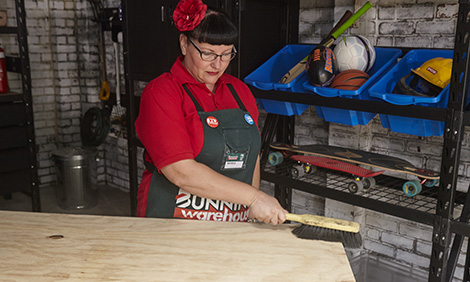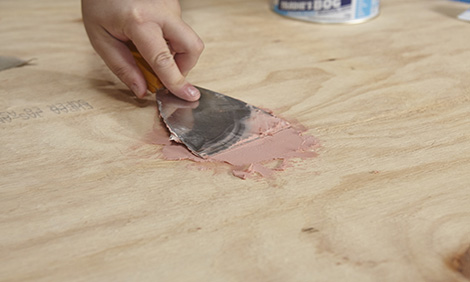How to Waterproof Plywood Sheets, Deck & Paint from Water Damage
Plywood is a readily available material that is hugely used in residential and commercial projects. Because it is affordable and easy to install, many DIY workers or painters prefer plywood over anything. Plywood is used for both indoor and outdoor purposes.
But the problem is it is not waterproofed like plastic, which causes rotting and peeling apart. That’s why it’s important to waterproof it.
There are many kinds of waterproofing. Most of them are DIY projects, which are so comfortable. It will save you time and money. However, many of us don’t know how to waterproof plywood sheets, deck or paint. That’s why in this article, we are going to let you know some waterproofing process so that you can protect your plywood from water damage easily. Stay tuned.

Table of Contents:=>
Why Plywood is Vulnerable to Water
We all know what plywood is. But do we know what plywood is made of? Well, plywood is originally some thin layers of softwood adjoined together by adhesive glue and completed using veneer.
Moreover, Plywood includes several layers of veneers. The cause of being vulnerable is mainly several layers of veneer. It damages the moisture of plywood and let the plywood become vulnerable to water. For that reason, the plywood will disintegrate if it is exposed to the water.
Also, the wood will rot gradually, and the flakes will peel away. Thus, the thin layers will separate in the end and also can grow mold. Well, there are few ways of preventing this problem. Take a look!
- Keep your plywood covered during the process of construction
- To apply the waterproofing element, apply a paintbrush
- Apply varnish to seal the plywood which will protect it from water
- Apply latex for aesthetic yet powerful protection
For Indoor or Outdoor
If you want to protect your plywood from water, first you have to be sure where it will be used. Because outdoor and indoor, there are different concerns and process as well.
If the moisture and water issue is subtle where the plywood is going to be used, then penetrating oil will be sufficient.
On the other side, if the plywood is going to be used for outdoor purposes, then you have to apply a full protective coat by using either paintbrush or spray to protect the plywood fully.
Different Types of Waterproofing
You will find many kinds of waterproofing options in the market, which will protect your plywood from water. Some of them are:
- Spray on or paint on waterproofing
- Penetrating oils
- Sealers
- Sheet plastics
Spray on or paint on is the most common type of waterproofing that is used for home improvement. These sprays on and paint on waterproofing is usually liquid latex element. You have to apply this when the surface is wet. After drying, the plywood will form into plastic, which will work as a protective layer.
Sealer and penetrating are another form of waterproofing, which also gives adequate protection. You can apply the sealer with a sprayer or a brush. Sheets plastics are also acceptable. But it needs to be stapled or tacked up.
How to Waterproof Plywood with Liquid Latex [Indoor] in 5 steps:
1) Clean The Surface:

Before you start sanding the plywood surface, take your dustpan brush and clean the plywood surface to clear away any debris.
2) Apply wood Filler:

To get a smooth finish, you need to fill up any plywood holes. Mix some Builder’s Bog up with some hardener on a piece of hardboard with your putty knife.
Once you’ve mixed the wood filler together, use your scraper to fill the plywood holes with it. If you’re fussy about the edges of the plywood and don’t want to see the end grain, apply the wood filler to edges of plywood also.

3) Sand the Plywood Surface:

After that, you have to sand the plywood when the periphery dries. It lightly with 100 grit or 200 grit sandpaper. It will give you a smoother surface, which will help you apply the waterproofing element more successfully.

4) Tape areas you don’t want to paint:
You should Mask any plywood areas that you don’t want to be covered in paint with some painter’s tape.
5) Apply Liquid Latex [waterproof Primer, Paint or Finish]:

Once you are done with one side of the plywood, flip it to the other side and thoroughly apply the liquid latex. Also, apply latex to the edges and corner of the plywood as well. It is essential to waterproof the edges as they are more exposed and wick up water quickly.
For best results, apply as many coats of latex or any other waterproofing material as possible. Usually, three coatings seem fair.

6) Drying:
Now, wait till the liquid latex dries. Once it dries, it will look like plastic. This is the layer that will protect your plywood from water, moisture, and other pieces of stuff.
Tip: You can use both roller and brush to apply the liquid. Using a roller is relatively more comfortable than a brush. Also, you can spray as well. If you want to spray, then an electric sprayer is the best option for you.

However, if you follow this process entirely, then you will get a perfect waterproof sheet.
How to Seal Plywood from Water for outdoor use [Epoxy sealer method]
The waterproofing process of indoor and outdoor plywood is different. If you want to use plywood for outdoor purposes, then applying an epoxy seal is the best option.
It protects plywood from water and conditions the softwood as well.
You will need the following things to seal the plywood. You will find these in any local hardware store. They are,
- Epoxy sealer or any other good water sealer
- Exterior polyurethane varnish
- Stain brush
- Water-based stain
- Garden sprayer

First, you have to apply exterior polyurethane varnish to seal the edges of the plywood. Use a stain brush for applying. However, make sure that the varnish is away from the plywood periphery.

Then, take a sprayer to apply the coat on the plywood periphery. Use an exterior water-based stain for coating. This will tint the plywood and protect it from ultraviolet damage.
After applying the coat, let it dry for at least 24 hours.

After that, apply an epoxy sealer or any other good sealer. For applying the sealer, you can use a garden sprayer. You have to apply several coats for better results. Also, repeat this process of sealing within every two years. Read Also: Staining Birch Plywood: 4 Steps to Get a Richer Finish.
Different Uses of Waterproof plywood
Plywood can be used in many different places. It can be used both indoor and outdoor. For instance, you can use waterproof plywood for the boat, deck, floor, door, etc. Here we will discuss different uses of waterproof plywood. Don’t go anywhere.
1. Waterproof Plywood for Boat [wood Sealant method]

Many people have boats either for business purposes or hobbies. If you are one of the people, it normally knows the importance of waterproofing plywood for the boat.
We all know there is constant contact with water when it comes to the boat. Thus, it is essential to waterproof plywood.
Usually, marine plywood is used for boat. UV rays also damage the plywood. That’s why it is necessary. You can waterproof plywood for the boat very quickly. Here is the process.
Things You Will Need:
- Sandpaper
- Cloth
- Sealant
- Paintbrush
Marine plywood is different from other plywood. Ordinary plywood usually has 3 to 5 layers, while marine plywood has ten layers or more.
However, there are several ways of waterproofing plywood for a boat. Among them, the best is using a wooden sealant. You can choose any suitable sealant.

First, sand the plywood surface with 80 grit sandpaper. Sand the whole surface thoroughly so that the plywood becomes ready to seal.
After sanding, clean the surface well with a cloth. If needed, use water to wash it. Make sure there is no debris left. If you wash it, then wait until it dries before you start sealing.
Now, apply a coating of a seal. Hold a paintbrush and apply a thin layer of seal and wait until the layer dries. Don’t forget to seal the edges and corners. It usually takes four to ten hours to dry one single layer of a seal.
After drying one layer, apply another layer and let it dry again. Repeat this overmentioned process as many times as needed, but make sure that the precious layer of coating dries well. This is how you waterproof plywood for a boat.
2. Waterproof Plywood Deck / Floor [wood sealers Method]

The deck is an integral part of many houses, and it needs to be waterproofed. Some decks look clean and waterproof, while others look messy. Exposed wood is the cause of this. The waterproof deck is a bit harder. Well, there are so many choices to make your deck waterproof, just like any other home improvement products.
There are many waterproof wood sealers, but many of them might fail. In this guess, I am suggesting you use a liquid rubber waterproofing system. It ossifies the plywood deck and protects your deck. Choose the best one from the market.

Now, you must want to know about the process of waterproofing a deck. Well, follow the process below.
First, clean the surface and wipe it with a dry cloth if the surface is dry to make the surface dry and clean. After cleaning, take a suitable liquid rubber waterproofing. Then, apply a coat of the liquid rubber waterproofing and wait for at least 24 hours. Apply 2 to 4 coats of this. The number of coats is depended on the application.
Here I am suggesting you some tips which will make it easier for you. Make sure that the surface is clean, as dust can cause loss of adhesion. Also, you can apply it by using a brush or roller. It will smoothen the application. A paint sprayer also can be used.
Keep In Mind:
Nowadays, plywood is widely used both indoors and outdoors purposes. Also, it is a fantastic building material. If you compare this with other materials, you will understand how much the cost-effective option is this. But you have to waterproof is for your own good. As we know, plywood consists of softwood and glue that’s lost its moisture and get mold when it comes in a water touch. That’s why it is vital to waterproof it. It also increases the lifetime of the plywood.
Final Words:
You can use spray on or paint on waterproofing as it is used widely because of its easiness and good quality.
However, in the writing piece, we tried to give you all the information and process of waterproof plywood. We suppose now you know how to waterproof plywood sheets, boat, paint or floor. So, what are you waiting for? Follow these processes and make your own waterproof plywood at a reasonable price. If you have any ulterior questions or inquiries, let us know it then comment box.
Last Updated on November 14, 2021 by Rogers Weber
[As an Amazon Associate I earn from qualifying purchases.]


